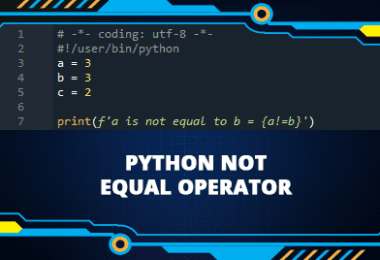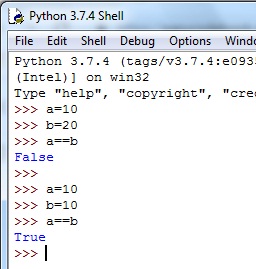

Once a condition succeeds, it will move on to the next block. In that case, you can use a nested if-else statement to check conditions in consecutive order. For example, suppose you have more than two options to handle in your code. In programming, “nesting” is a term that describes placing one programming construct inside another. The following flow chart demonstrates how an if-elif-else statement works in Python: If no expression is True, the else statement will execute.
#PYTHON NOT EQUAL IN IF STATEMENT CODE#
Once an expression is evaluated as True, that block of code will execute. The interpreter will evaluate multiple expressions one at a time, starting with the if statement. Once a condition is true, the interpreter executes that block of code. Here, each number from -2 to 1 gets passed through the if-elif-else statement. You can have any number of elif statements following an if statement. In that case, you can use elif to look for the other specified condition before Python decides which action to take. For example, suppose the first statement is false, but you want to check for another condition before executing the else block.

#PYTHON NOT EQUAL IN IF STATEMENT SERIES#
It enables you to perform a series of checks to evaluate the conditions of multiple expressions. The following flow chart demonstrates how an if statement works in Python:Įlif is the shortened version of else if.

If it is false, the statement(s) will not be executed. If it is true, the statement (or statements) will be executed. Remember that non-zero values are interpreted by Python as True while None and 0 are False.įirst, the program evaluates your test expression. The body of a Python if statement begins with indentation. In other words, it enables the programmer to run a specific code only when a certain condition is met. If is a conditional statement used for decision-making operations. An elif statement is used to check the conditions for multiple expressions. The else statement contains the block of code that will execute if the condition from the if statement is false or resolves to zero.Īn if-else statement is used to execute both the true and false parts of a condition.Įlif is the shortened version of else if. If the condition is true, the “if” block of code will be executed. It dictates whether a statement should be executed or not by checking for a given condition. They are interpreted to produce some other value. Unlike statements which are created to do something, expressions are representations of value. In programming, syntax is the set of rules that defines the structure of a language. In programming, logic is the automatic reasoning backed by those facts and rules. You can use conditions to provide different instructions to your program depending on the answer.Ĭomputation follows facts and rules. In programming, a condition is something the computer can decide to be true or false.


 0 kommentar(er)
0 kommentar(er)
